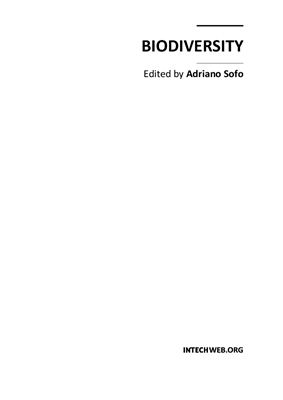InTech. 2011. 148 p.
Biodiversity is strongly affected by the rapid and accelerating changes in the global climate, which largely stem from human activity. Anthropogenic activities are causing highly influential impacts on species persistence. The sustained environmental change wildlife is experiencing may surpass the capacity of developmental, genetic, and demographic mechanisms that populations have developed to deal with these alterations. How biodiversity is perceived and maintained affects ecosystem functioning as well as how the goods and services that ecosystems provide to humans can be used. Recognizing biodiversity is essential to preserve wildlife. Furthermore, the measure, management and protection of ecosystem biodiversity requires different and innovative approaches. For all these reasons, the aim of the present book is to give an up-to-date overview of the studies on biodiversity at all levels, in order to better understand the dynamics and the mechanisms at the basis of the richness of life forms both in terrestrial (including agro-ecosystems) and marine environments.
Contents
Ecosystem-Level Biodiversity
Integrating Spatial Behavioral Ecology in Agent-Based Models for Species Conservation
Evolution of Ecosystem Services in a Mediterranean Cultural Landscape: Do?ana Case Study, Spain (1956-2006)
Organism-Level Biodiversity
Implications of Wood Collecting Activities on Invertebrates Diversity of Conservation Areas
Cell Surface Display
Biological Cr(VI) Reduction: Microbial Diversity, Kinetics and Biotechnological Solutions to Pollution
Biodiversity Measures
Biodiversity Measures in Agriculture Using DNA
Molecular Techniques to Estimate Biodiversity with Case Studies from the Marine Phytoplankton
Biodiversity is strongly affected by the rapid and accelerating changes in the global climate, which largely stem from human activity. Anthropogenic activities are causing highly influential impacts on species persistence. The sustained environmental change wildlife is experiencing may surpass the capacity of developmental, genetic, and demographic mechanisms that populations have developed to deal with these alterations. How biodiversity is perceived and maintained affects ecosystem functioning as well as how the goods and services that ecosystems provide to humans can be used. Recognizing biodiversity is essential to preserve wildlife. Furthermore, the measure, management and protection of ecosystem biodiversity requires different and innovative approaches. For all these reasons, the aim of the present book is to give an up-to-date overview of the studies on biodiversity at all levels, in order to better understand the dynamics and the mechanisms at the basis of the richness of life forms both in terrestrial (including agro-ecosystems) and marine environments.
Contents
Ecosystem-Level Biodiversity
Integrating Spatial Behavioral Ecology in Agent-Based Models for Species Conservation
Evolution of Ecosystem Services in a Mediterranean Cultural Landscape: Do?ana Case Study, Spain (1956-2006)
Organism-Level Biodiversity
Implications of Wood Collecting Activities on Invertebrates Diversity of Conservation Areas
Cell Surface Display
Biological Cr(VI) Reduction: Microbial Diversity, Kinetics and Biotechnological Solutions to Pollution
Biodiversity Measures
Biodiversity Measures in Agriculture Using DNA
Molecular Techniques to Estimate Biodiversity with Case Studies from the Marine Phytoplankton

